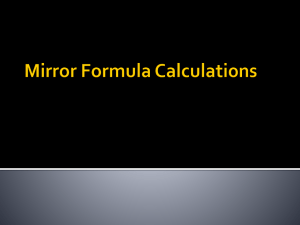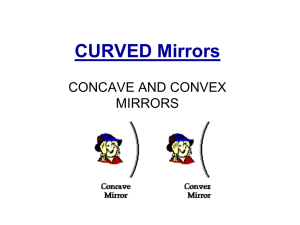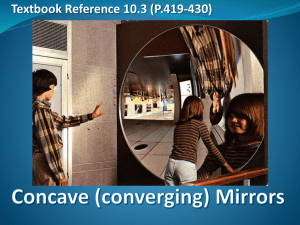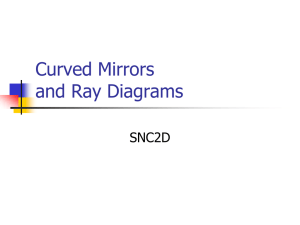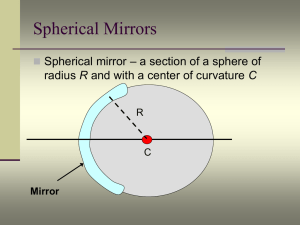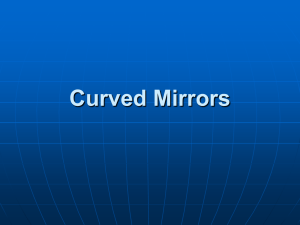23-SNC2P-Topic_4
advertisement
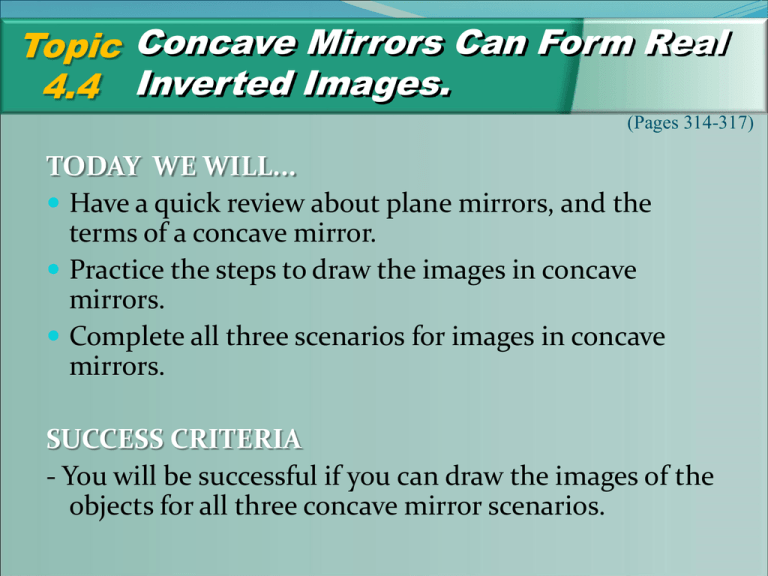
Topic Concave Mirrors Can Form Real 4.4 Inverted Images. (Pages 314-317) TODAY WE WILL... Have a quick review about plane mirrors, and the terms of a concave mirror. Practice the steps to draw the images in concave mirrors. Complete all three scenarios for images in concave mirrors. SUCCESS CRITERIA - You will be successful if you can draw the images of the objects for all three concave mirror scenarios. LET’S REVIEW ... LAST WEEK WE COVERED ... LAWS OF REFLECTION IMAGES IN PLANE MIRRORS THIS WEEK WE COVERED ... CONCAVE MIRRORS The angle of reflection is equal to the angle of incidence. Copyright © 2010 McGraw-Hill Ryerson Ltd. The Law of Reflection The Law of Reflection applies to every reflecting surface. The word “plane” refers to any flat surface. Copyright © 2010 McGraw-Hill Ryerson Ltd. WHAT IS AN IMAGE? When you see an object reflected in a mirror, you do not see the object itself. Instead, you see an IMAGE of the object. IMAGE: a picture or reproduction of an object formed using light. Ray Diagrams for Plane Mirrors You need just two rays reflecting from a mirror to find the point where the reflection of an object is located. The virtual image is an image located where no light rays ever meet. Rays must be extended behind the mirror to find where they meet. • OBJECT: the item in front of the mirror • IMAGE: the reflection of the object in the mirror • OBJECT DISTANCE: the distance from the mirror to the object • IMAGE DISTANCE: the distance from the mirror to the image. Copyright © 2010 McGraw-Hill Ryerson Ltd. CHARACTERISTICS OF IMAGES IN A PLANE MIRROR Describe the image characteristics for an image in a plane (flat) mirror. SIZE: Same size as the object. ATTITUDE: Upright ... Image is oriented in the same direction as the object. LOCATION: Image is behind the mirror, and the image distance is equal to the object distance. TYPE: The image is virtual. Curved Mirrors There are two types of curved mirrors: Concave (converging) Convex (diverging) Concave Mirrors Vertex (V) Principle Axis (PA) Centre of Curvature (C) Focal length (f) Focus (F) 2 times the focal length (2f) Concave mirrors ... terms PRINCIPAL AXIS (PA): a straight line that passes through the centre of curvature, C, to the midpoint of the mirror VERTEX (V): the point where the principal axis meets the mirror FOCAL POINT [or focus] (F): the point where all light rays that are parallel and close to the principal axis reflect from the mirror and meet CENTRE OF CURVATURE (C): the centre of the sphere that the mirror fits on. The focal point is exactly halfway between C and the mirror. RADIUS OF CURVATURE: the distance between C and V FOCAL LENGTH (f): the distance from the focal point to the mirror WORKSHEET 4.4C Images in curved mirrors have 4 key characteristics: SIZE • Is the image larger, smaller, or the same size compared to the object? ATTITUDE • Is the image upright (right side up) or inverted (upside down)? LOCATION • Where is the image located? TYPE • Is the image real or virtual? RECALL ... Ray Diagrams for Concave Mirrors There are three regions where an object can be located: •beyond C •between C and F •between the mirror and F Locating Images in Concave Mirrors To find the image of an object in front of a concave mirror, you need to draw at least two incident rays from the top of the object. RULES: 1. The first ray is drawn parallel to the principal axis, and it will reflect back through the focal point. Locating Images in Concave Mirrors RULES ... Cont’d: 2. The second ray is drawn from a point on the object through the focal point toward the mirror, and it will reflect back, parallel to the principal axis. Ray Diagrams for Objects between F and C for Concave Mirrors Pg.314 Copyright © 2010 McGraw-Hill Ryerson Ltd. Ray Diagrams for Objects between F and C for Concave Mirrors Pg.314 The 4 characteristics of the image of an object placed between F and C of a concave mirror are: • S: the image is larger than the object • A: the image is inverted • L: the image is farther from the mirror than the object • T: the image is real Copyright © 2010 McGraw-Hill Ryerson Ltd. Ray Diagrams for Concave Mirrors The three regions where an object can be located: •beyond C between C and F •between the mirror and F Copyright © 2010 McGraw-Hill Ryerson Ltd. Concave mirrors can form upright, virtual images. The image below shows how concave mirrors can form magnified, upright images, much like a makeup mirror does. For this to occur the object must be between the mirror and the focal point (F). If not, the image is inverted. Copyright © 2010 McGraw-Hill Ryerson Ltd. Ray Diagrams for an Object between a Concave Mirror and the Focal Point Pg.317 Copyright © 2010 McGraw-Hill Ryerson Ltd. Ray Diagrams for an Object between a Concave Mirror and the Focal Point Pg.317 Copyright © 2010 McGraw-Hill Ryerson Ltd. Ray Diagrams for an Object between a Concave Mirror and the Focal Point Pg.317 The 4 characteristics of the image of an object placed between F and the concave mirror are: • S: the image is larger than the object • A: the image is upright • L: the image is farther from the mirror than the object • T: the image is virtual Copyright © 2010 McGraw-Hill Ryerson Ltd. Ray Diagrams for Concave Mirrors The three regions where an object can be located: •beyond C between C and F between the mirror and F Ray Diagrams for an Object beyond C Use the same directions on page 314 (Object between C and F) to draw the ray diagram. 1. The first ray is drawn parallel to the principal axis, and it will reflect back through the focal point. 2. The second ray is drawn from a point on the object through the focal point toward the mirror, and it will reflect back, parallel to the principal axis. Ray Diagram for an object located beyond C The 4 characteristics of the image of an object placed beyond C are: • S: the image is smaller than the object • A: the image is inverted • L: the image is located between C and F • T: the image is real SUMMARY: IMAGE CHARACTERISTICS OF A CONCAVE MIRROR OBJECT LOCATION Between F and mirror Between C and F Beyond C IMAGE CHARACTERISTICS SIZE ATTITUDE (smaller, larger, or same) (inverted or upright) LOCATION TYPE (Real or virtual) SUMMARY: IMAGE CHARACTERISTICS OF A CONCAVE MIRROR OBJECT LOCATION IMAGE CHARACTERISTICS SIZE ATTITUDE LOCATION TYPE (smaller, larger, or same) (inverted or upright) Between F and mirror LARGER UPRIGHT BEHIND MIRROR VIRTUAL Between C and F LARGER INVERTED BEYOND C REAL Beyond C SMALLER INVERTED BETWEEN C&F REAL (Real or virtual)

